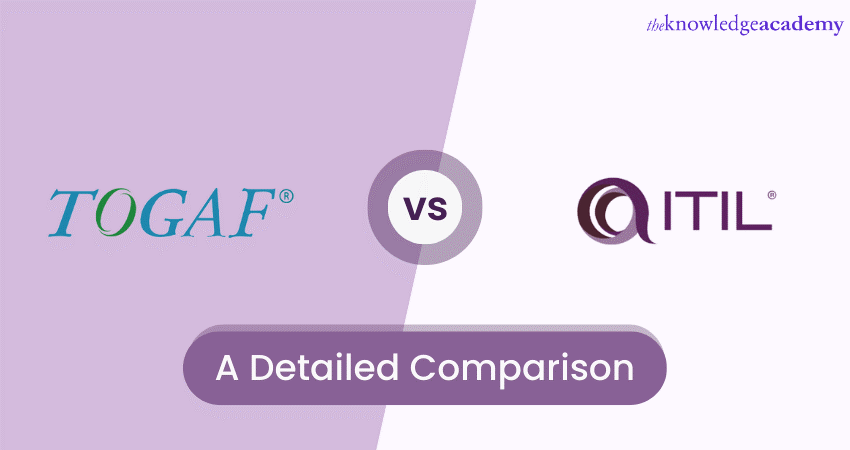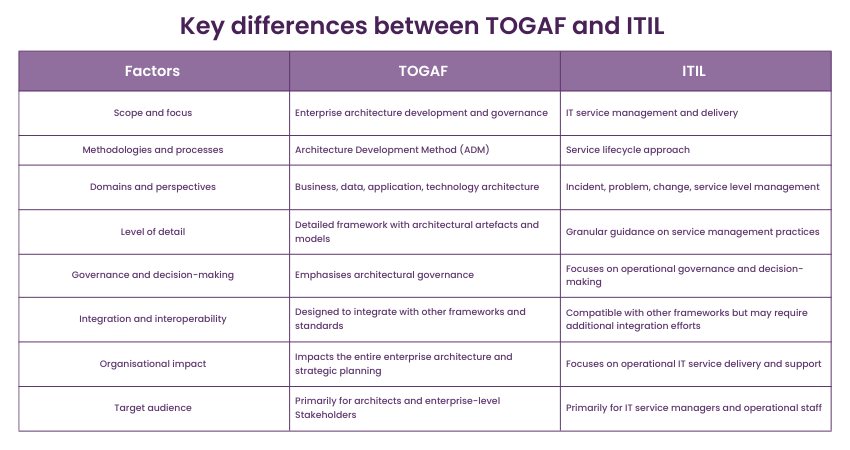We may not have the course you’re looking for. If you enquire or give us a call on 01344203999 and speak to our training experts, we may still be able to help with your training requirements.
Training Outcomes Within Your Budget!
We ensure quality, budget-alignment, and timely delivery by our expert instructors.

While choosing the right framework for Enterprise Architecture and IT Service Management, organisations often ask: TOGAF vs ITIL, which is the best? Well, both TOGAF and Information Technology Infrastructure Library (ITIL) are leading approaches for organisations seeking to optimise their technology initiatives and operational efficiency.
However, these frameworks also have multiple differences. Without understanding these differences, organisations cannot make well-informed decisions about which framework suits their unique requirements, enabling them to drive enterprise architecture development and streamline IT service management effectively. This blog delves into explaining the differences between the TOGAF vs ITIL and their features. Also, learn how they benefit specific areas of emphasis within each framework.
Table of Contents
1) Overview of TOGAF
2) Overview of ITIL
3) Key differences between TOGAF and ITIL
4) ITIL OR TOGAF? Which framework to choose?
5) Conclusion
Overview of TOGAF
One of the widely recognised and comprehensive enterprise architecture development and governance framework is TOGAF. It provides a structured approach to creating, managing, and aligning an organisation's architecture assets, ensuring they support the overall business strategy and objectives.
By providing a standardised framework and common language for architecture development, TOGAF enhances communication and collaboration among stakeholders. It also fosters agility, effectively allowing organisations to adapt to changes and updates in the business environment and technological advancements.
Therefore, by leveraging its comprehensive methodology and addressing various architecture domains, organisations can establish a strong foundation for aligning their IT capabilities with business objectives, ultimately driving organisational success and growth. The following are some benefits of using TOGAF for business architectural development:
a) Holistic framework for enterprise architecture development and governance
b) Alignment of IT capabilities with business objectives
c) Consistency and efficiency in architecture development processes
d) Improved decision-making based on business requirements and architectural principles
e) Enhanced communication and collaboration among stakeholders
f) Scalability and adaptability to different organisational needs
g) Industry recognition, support, and opportunities for professional growth

Overview of ITIL
ITIL is a globally recognised framework for managing IT services and processes. At its core is the ITIL Service Lifecycle, which consists of five stages. Each stage focuses on specific activities and processes to deliver and maintain high-quality IT services.
It offers a comprehensive set of best practices and guidelines that help organisations align their IT services with business needs and improve overall service quality. By adopting ITIL, organisations can benefit from improved service quality, reduced downtime, enhanced customer satisfaction, and better alignment of IT services with business objectives. Therefore, it promotes a systematic approach to service management, emphasising continuous improvement and a customer-centric mindset. Implementing ITIL for better service management is beneficial to businesses in the following ways:
1) Improved service quality and customer satisfaction
2) Streamlined operational processes
3) Faster problem resolution
4) Efficient change management
5) Enhanced service availability and reduced downtime
6) Clear service level agreements and performance monitoring
7) Industry recognition and support for IT service management best practices
Learn ITIL by signing up for our ITIL Certification Training courses. Join now!
Key differences between TOGAF and ITIL
After briefly reading about ITIL and TOGAF, it's time to understand their differences. Here are the factors explained in detail, based on which you can differentiate between these two architectural development frameworks:
Scope and focus
TOGAF primarily focuses on enterprise architecture development and governance. It provides a holistic framework for creating, managing, and aligning architectures across domains. In contrast, ITIL centres around managing IT services and processes. It offers a set of practices for delivering and maintaining high-quality IT services.
Methodologies and processes
Based on the TOGAF Architecture Principles, the Architecture Development Method (ADM) is an iterative and phased approach. It is used for architecture development. It emphasises creating architectural artefacts and aligning them with business objectives. Contrarily, ITIL follows a service lifecycle approach that covers the entire lifespan of IT services. It focuses on processes and practices for service strategy, design, transition, operation, and improvement.
Domains and perspectives
TOGAF covers architecture domains such as business, data, application, and technology architecture. It provides a comprehensive view of an organisation's architectural landscape. In contrast, services such as ITIL Incident Management, problem management, change management, and service level management are a part of ITIL. This framework concentrates on ensuring the effective delivery and support of IT services.
Level of detail
TOGAF provides a detailed methodology and framework for creating and managing enterprise architectures. It encompasses various architectural artefacts, models, and guidelines. ITIL, on the other hand, offers more specific guidance on service management practices and processes. It focuses on operational activities, workflows, and documentation for managing IT services.
Governance and decision-making
TOGAF places significant emphasis on establishing a governance framework for enterprise architecture. It includes principles, guidelines, and governance processes to ensure consistency, compliance, and strategic alignment. At the same time, ITIL, while incorporating governance aspects, primarily focuses on operational governance and decision-making related to service management practices.
Integration and interoperability
TOGAF is designed to integrate with other frameworks and standards, allowing organisations to leverage existing architectural assets and align with industry practices. Although compatible with other frameworks, ITIL primarily focuses on service management and may require additional integration efforts for seamless interoperability with other architectural frameworks.
Organisational impact
TOGAF has a broad organisational impact, influencing the enterprise’s strategic planning and decision-making. It fosters collaboration among departments and teams, ensuring architecture development aligns with business objectives and improves operational efficiency.
In contrast, ITIL’s impact focuses more on the IT department, enhancing its operational processes and service delivery. It improves service quality, customer satisfaction, and operational efficiency by implementing best practices for incident, problem, change, and service level management.
Target audience
While the target audience for TOGAF focuses on strategic and architectural aspects, the target audience for ITIL is more operational and centred around service management. However, there can be overlap, as architects involved in enterprise architecture development may also benefit from understanding ITIL practices for effective service delivery.
Understanding the difference between TOGAF and ITIL is essential, mainly because they are not mutually exclusive. Organisations can benefit from integrating both frameworks to achieve comprehensive IT governance, from architectural development to effective service management.
Similarly, adopting one or both frameworks is based on an organisation's specific needs, objectives, and maturity in enterprise architecture and IT service management.
Take your IT service management skills to the next level with our ITIL® 4 Foundation Certification Training Course.
TOGAF or ITIL? Which one to choose?
When deciding between TOGAF vs ITIL, organisations should carefully evaluate their specific needs, objectives, and priorities to choose the most suitable framework. The following points must be considered when making the decision:

a) Scope and focus: Consider whether your organisation's primary focus is on enterprise architecture development and governance (TOGAF) or ITIL Service Management and delivery. Assess which area aligns more closely with your current challenges and strategic goals.
b) Organisational requirements: Evaluate the specific requirements and pain points of your organisation. Determine whether you need a comprehensive framework to align IT capabilities with business objectives (TOGAF) or require more guidance on operational processes and service management.
c) Maturity and readiness: Assess your organisation’s maturity and readiness regarding enterprise architecture and IT service management. Consider the level of expertise and resources available within your organisation to implement TOGAF and ITIL and adopt the chosen framework effectively.
d) Integration potential: Evaluate how well each framework integrates with your existing processes, frameworks, and standards. Consider whether integration with other architectural or service management frameworks is essential for your organisation's success.
e) Training and certification: Explore the availability of training and certification programs for both ITIL and TOGAF. Consider the skill sets and competencies your organisation requires and assess the available resources and support for training and certification in the chosen framework.
f) Industry recognition and best practices: Research the industry recognition and adoption of both frameworks. Consider industry standards and best practices prevalent in your sector and assess how well each framework aligns with them.
Join our TOGAF® Foundation And Practitioner Training to become familiar with the important information of different ADM phases.
Conclusion
TOGAF vs ITIL, choosing between the two requires careful consideration of organisational needs, objectives, and maturity. While TOGAF focuses on enterprise architecture and governance, ITIL centres around IT service management. Integrating both frameworks can provide a comprehensive approach.
Frequently Asked Questions
Upcoming IT Service Management Resources Batches & Dates
Date
 TOGAF® Foundation and Practitioner Training
TOGAF® Foundation and Practitioner Training
Sat 3rd Aug 2024, Sun 4th Aug 2024
Mon 5th Aug 2024
Mon 12th Aug 2024
Sat 17th Aug 2024, Sun 18th Aug 2024
Mon 19th Aug 2024
Mon 2nd Sep 2024
Sat 7th Sep 2024, Sun 8th Sep 2024
Mon 9th Sep 2024
Mon 16th Sep 2024
Sat 21st Sep 2024, Sun 22nd Sep 2024
Sat 5th Oct 2024, Sun 6th Oct 2024
Mon 7th Oct 2024
Mon 14th Oct 2024
Mon 21st Oct 2024
Sat 2nd Nov 2024, Sun 3rd Nov 2024
Mon 4th Nov 2024
Mon 11th Nov 2024
Sat 16th Nov 2024, Sun 17th Nov 2024
Mon 18th Nov 2024
Mon 2nd Dec 2024
Sat 7th Dec 2024, Sun 8th Dec 2024
Mon 9th Dec 2024
Mon 16th Dec 2024
Mon 6th Jan 2025
Mon 27th Jan 2025
Mon 3rd Feb 2025
Mon 10th Feb 2025
Mon 17th Feb 2025
Mon 24th Feb 2025
Mon 3rd Mar 2025
Mon 10th Mar 2025
Mon 17th Mar 2025
Mon 24th Mar 2025
Mon 31st Mar 2025
Mon 7th Apr 2025
Tue 22nd Apr 2025
Tue 6th May 2025
Mon 12th May 2025
Mon 19th May 2025
Mon 2nd Jun 2025
Mon 9th Jun 2025
Mon 16th Jun 2025
Mon 23rd Jun 2025
Mon 7th Jul 2025
Mon 21st Jul 2025
Mon 28th Jul 2025
Mon 4th Aug 2025
Mon 11th Aug 2025
Mon 18th Aug 2025
Mon 1st Sep 2025
Mon 8th Sep 2025
Mon 15th Sep 2025
Mon 22nd Sep 2025
Mon 29th Sep 2025
Mon 6th Oct 2025
Mon 13th Oct 2025
Mon 20th Oct 2025
Mon 27th Oct 2025
Mon 3rd Nov 2025
Mon 10th Nov 2025
Mon 17th Nov 2025
Mon 24th Nov 2025
Mon 1st Dec 2025
Mon 8th Dec 2025
Mon 15th Dec 2025







 Top Rated Course
Top Rated Course


 If you wish to make any changes to your course, please
If you wish to make any changes to your course, please


